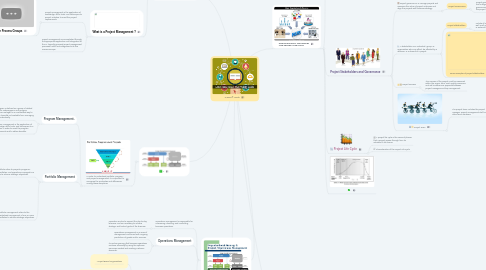
1. .
1.1. In order to understand portfolio, program, and project management, it is important to recognize the similarities and differences among these disciplines.
1.1.1. Program Management.
1.1.1.1. A program is defined as a group of related projects, subprograms, and program activities managed in a coordinated way to obtain benefits not available from managing them individually.
1.1.1.2. Program management is the application of knowledge, skills, tools, and techniques to a program in order to meet the program requirements and to obtain benefits.
1.1.2. Portfolio Management
1.1.2.1. A portfolio refers to projects, programs, subportfolios, and operations managed as a group to achieve strategic objectives.
1.1.2.1.1. Projects and Strategic Planning
1.1.2.1.2. Project Management Office
1.1.2.2. Portfolio management refers to the centralized management of one or more portfolios to achieve strategic objectives.
2. .
2.1. Operations management is responsible for overseeing, directing, and controlling business operations.
2.1.1. Operation evolve to support the day-to-day business, and are necessary to achieve strategic and tactical goals of the business.
2.2. Operations Management
2.2.1. Operations management is an area of management concerned with ongoing production of goods and/or services.
2.2.2. It involves ensuring that business operations continue efficiently by using the optimum resources needed and meeting customer demands.
2.3. Organizations and Project Management
2.3.1. . Project-Based Organizations
2.3.2. . The Link Between Project Management and Organizational Governance
2.3.3. . The Link Between Project Management and Organizational Governance
3. Purpose of the PMBOK® Guide
3.1. What is a Project ?
3.1.1. A project is a effort temporary to create a unique product, service, or result. The temporary nature of projects indicates that a project has a definite beginning and end.
3.1.1.1. Examples of projects
3.1.1.1.1. . Developing a new product, service.
3.1.1.1.2. . Constructing a industrial plant.
3.2. What is a Project Management ?
3.2.1. Project management is the application of knowledge, skills, tools, and techniques to project activities to meet the project requirements.
3.2.1.1. Five Process Groups
3.2.2. Project management is accomplished through the appropriate application and integration of the 47 logically grouped project management processes, which are categorized into five Process Groups.
4. Business Value
4.1. Business value is a concept that is unique to each organization;is the total sum of all tangible and intangible elements.
4.1.1. Role of the Project Manager
4.1.1.1. Is the person assigned by the performing organization to lead the team.
4.1.1.2. Interpersonal Skills of a Project Manager
5. ORGANIZATIONAL INFLUENCES AND PROJECT LIFE CYCLE
5.1. Organizational Influences on Project Management
5.1.1. An organization’s culture, style, and structure influence how its projects are performed.
5.1.2. these factors, and assets within an enterprise that are likely to influence the project.
5.1.2.1. Organizational Cultures and Styles
5.1.2.2. Organizational Communications
5.1.2.3. Organizational Structures
5.1.2.3.1. Functional Organization
5.1.2.3.2. Weak Matrix Organization
5.1.2.3.3. Balanced Matrix Organization
5.1.2.3.4. Projectized Organization
5.1.2.4. Enterprise Environmental Factors
5.1.2.4.1. • Organizational culture, structure, and governance
5.1.2.4.2. .• Company work authorization systems
5.1.2.4.3. .• Company work authorization systems
5.1.2.4.4. • Stakeholder risk tolerances
5.1.2.4.5. • Political climate
5.2. Project Stakeholders and Governance
5.2.1. Project governance is manage projects and maximize the value of project outcomes and align the projects with business strategy.
5.2.1.1. Project Governance
5.2.1.1.1. Project governance is an oversight function that is aligned with the organization’s governance model and that encompasses the project life cycle.
5.2.2. A stakeholder is an individual, group, or organization who may affect, be affected by a decision, or outcome of a project.
5.2.2.1. Project Stakeholders
5.2.2.1.1. Include all members of the project team as well as all interested entities that are internal or external to the organization.
5.2.2.2. Some examples of project stakeholders:
5.2.2.2.1. • Sponsor.
5.2.2.2.2. • Customers and users.
5.2.2.2.3. • Sellers.
5.2.2.2.4. • Business partners.
5.2.2.2.5. • Organizational groups.
5.2.2.2.6. • Functional managers.
5.2.2.2.7. • Other stakeholders.
5.2.3. Project Success
5.2.3.1. The success of the project must be measured within the scope, time, cost, quality, resources and risk limitations as approved between project managers and top management.
5.2.4. Project Team
5.2.4.1. The project team includes the project manager, project management staff, and other team members.
5.2.4.1.1. • Project management staff.
5.2.4.1.2. • Project staff.
5.2.4.1.3. • Supporting experts.
5.2.4.1.4. • User or Customer Representatives.
5.2.4.1.5. • Sellers.
5.2.4.1.6. • Business partners.
5.3. Project Life Cycle
5.3.1. A project life cycle is the series of phases that a project passes through from its initiation to its closure.
5.3.2. Characteristics of the Project Life Cycle
5.4. .
6. Project Phases
6.1. A project may be divided into any number of phases.
6.1.1. Example of a Single-Phase Projec.

